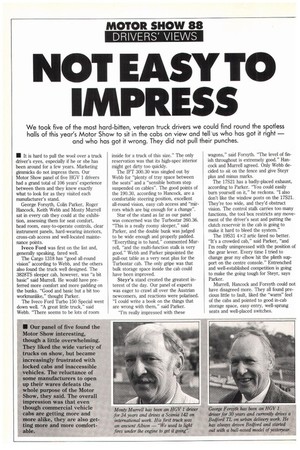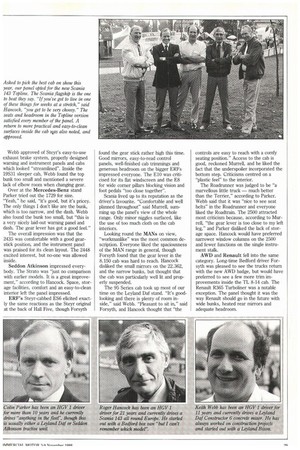NOT EASY TO IMPRESS
Page 26

Page 27

If you've noticed an error in this article please click here to report it so we can fix it.
We took five of the most hard-bitten, veteran truck drivers we could find round the spotless halls of this year's Motor Show to sit in the cabs on view and tell 'us who has got it right — and who has got it wrong. They did not pull their punches.
IN It is hard to pull the wool over a truck driver's eyes, especially if he or she has been around for a few years. Marketing gimmicks do not impress them. Our Motor Show panel of five HGV 1 drivers had a grand total of 106 years' experience between them and they knew exactly what to look for as they visited each manufacturer's stand.
George Forsyth, Colin Parker, Roger Hancock, Keith Webb and Monty Murrell sat in every cab they could at the exhibition, assessing them for seat comfort, head room, easy-to-operate controls, clear instrument panels, hard-wearing interiors, cross-cab access and well-located maintenance points.
Iveco Ford was first on the list and, generally speaking, fared well.
The Cargo 1318 has "good all-round vision" according to Webb, and the others also found the truck well designed. The 3828TS sleeper cab, however, was "a bit basic" said Murrell. He would have preferred more comfort and more padding on the bunks. "Good and basic but a bit too workmanlike," thought Parker.
The Iveco Ford Turbo 150 Special went down well. "A great little truck," said Webb. "There seems to be lots of room inside for a truck of this size." The only reservation was that its high-spec interior might get dirty too quickly.
The IFT 300.30 was singled out by Webb for "plenty of tray space between the seats" and a "sensible bottom step suspended on cables". The good points of the 190.30, according to Hancock, are a comfortable steering position, excellent all-round vision, easy cab access and "mirrors which are big enough for a change".
Star of the stand as far as our panel was concerned was the Turbostar 260.36. "This is a really roomy sleeper," said Parker, and the double bunk was judged to be wide enough and properly padded. "Everything is to hand," commented Murrell, "and the multi-function stalk is very good." Webb and Parker pinpointed the pull-out table as a very neat plus for the Turbostar cab. The only gripe was that bulk storage space inside the cab could have been improved.
Steyr's stand created the greatest interest of the day. Our panel of experts was eager to crawl all over the Austrian newcomers, and reactions were polarised. "I could write a book on the things that are wrong with them," said Parker.
"I'm really impressed with these wagons," said Forsyth. "The level of finish throughout is extremely good." Hancock and Murrell agreed. Only Webb decided to sit on the fence and give Steyr plus and minus marks.
The 17521 has a badly-placed exhaust, according to Parker. "You could easily burn yourself on it," he reckons. "I also don't like the window posts on the 17S21. They're too wide, and they'd obstruct vision. The control stalk carries too many functions, the tool box restricts any movement of the driver's seat and putting the clutch reservoir in the cab is going to make it hard to bleed the system."
The 19531 4x2 artic fared no better. "It's a crowded cab," said Parker, "and I'm really unimpressed with the position of the gear lever. Every time I tried to change gear my elbow hit the plinth support on the centre console." Entrenched and well-established competition is going to make the going tough for Steyr, says Parker.
Murrell, Hancock and Forsyth could not have disagreed more. They all found precious little to fault, liked the "warm" feel of the cabs and pointed to good in-cab storage space, easy entry, well-sprung seats and well-placed switches, Webb approved of Steyr's easy-to-use exhaust brake system, properly designed warning and instrument panels and cabs which looked "streamlined". Inside the 19S31 sleeper cab, Webb found the top bunk too small and mentioned a severe lack of elbow room when changing gear.
Over at the Mercedes-Benz stand Parker tried out the 1729 for size. "Yeah," he said, "it's good, but it's pricey. The only things I don't like are the bunk, which is too narrow, and the dash. Webb also found the bunk too small, but "this is a very nicely laid-out warning panel and dash. The gear lever has got a good feel."
The overall impression was that the 2435 was comfortable with a good gearstick position, and the instrument panel was praised for its clean layout. The 2448 excited interest, but no-one was allowed inside.
Seddon Atkinson impressed everybody. The Strato was "just no comparison with earlier models. It is a great improvement," according to Hancock. Space, storage facilities, comfort and an easy-to-clean interior left the panel impressed.
ERF's Steyr-cabbed ES6 elicited exactly the same reactions as the Steyr original at the back of Hall Five, though Forsyth found the gear stick rather high this time. Good mirrors, easy-to-read control panels, well-finished cab trimmings and generous headroom on the bigger ERFs impressed everyone. The E 10 was criticised for its flat windscreen and the E8 for wide corner pillars blocking vision and foot pedals "too close together".
Scania lived up to its reputation as the driver's favourite. "Comfortable and well planned throughout" said Murrell, summing up the panel's view of the whole range. Only minor niggles surfaced, like the use of too much cloth on the cab interiors.
Looking round the MANs on view, "workmanlike" was the most common description. Everyone liked the spaciousness of the MAN range in general, though Forsyth found that the gear lever in the 8.150 cab was hard to reach. Hancock disliked the small mirrors on the 22.362, and the narrow bunks, but thought that the cab was particularly well lit and properly suspended.
The 95 Series cab took up most of our time on the Leyland Daf stand. "It's goodlooking and there is plenty of room inside," said Webb. "Pleasant to sit in," said Forsyth, and Hancock thought that "the controls are easy to reach with a comfy seating position." Access to the cab is good, reckoned Murrell, and he liked the fact that the underspoiler incorporated the bottom step. Criticisms centred on a "plastic feel" to the interior.
The Roadrunner was judged to be "a marvellous tittle truck — much better than the Terrier," according to Parker. Webb said that it was "nice to see seat belts" in the Roadrunner and everyone liked the Roadtrain. The 2500 attracted most criticism because, according to Murrell, "the gear lever is too close to my left leg," and Parker disliked the lack of storage space. Hancock would have preferred narrower window columns on the 2500 and fewer functions on the single instrument stalk.
AWD and Renault fell into the same category. Long-time Bedford driver Forsyth was pleased to see the trucks return with the new AWD badge, but would have preferred to see a few more trim improvements inside the IL 8-14 cab. The Renault R365 Turboliner was a notable exception. The panel thought it was the way Renault should go in the future with wide bunks, heated rear mirrors and adequate headroom.
























































